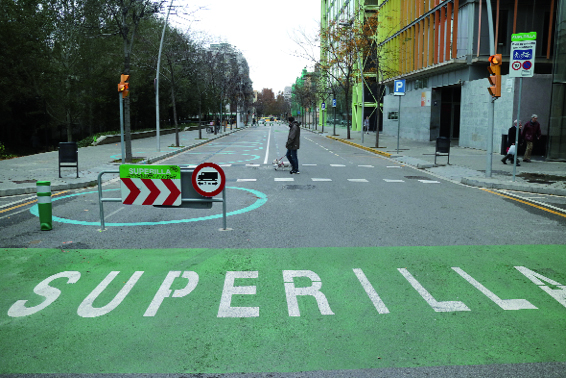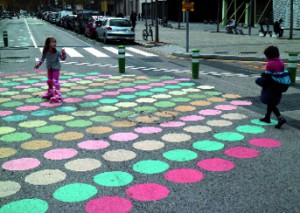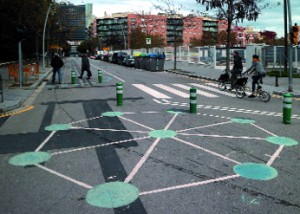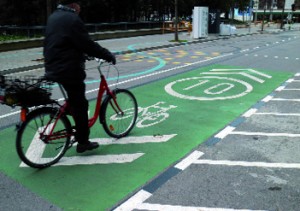The competitive cycle in which thousands of cities around the world are immersed, consuming resources as though they were limitless, is unsustainable and goes beyond the ability of certain key variables in our ecosystems to guarantee the survival of the planet.

Poblenou’s superblock, which covers blocks of houses between Carrers de Badajoz, Pallars, La Llacuna and Tànger. The superblock is the first of five such blocks that the City Council wants to establish over the coming years.
Photo: Vicente Zambrano
The city is the most complex ecosystem that mankind has created. It is the system that has the greatest impact on all our natural ecosystems, because it holds most of the planet’s human population and consumes around 70% of its energy. Cities compete with other territories. The scale of this competition depends on the size and characteristics of the city. Barcelona, for example, competes in the international sphere to attract investments, activities in the knowledge industry and resources of every kind.
The problem is that the competitive strategy that has been in place until now is based on an increasing consumption of resources. This incremental strategy translates into more use of land, materials and energy, which then leads to increased consumption of natural resources and a greater negative impact on the planet’s local and global ecosystems in the form of greenhouse gases, for example (global impact) or of emissions of pollutant gases and particulates (local impact) which in the Barcelona metropolitan area (56 council districts including the city itself) causes the premature death of 3,000 people a year.
The competitive cycle in which thousands of cities around the world are immersed, consuming resources as though they were limitless, is unsustainable and goes beyond the ability of certain key variables in our ecosystems to guarantee the survival of the planet. The most well-known phenomenon resulting from this excessive use of natural resources is climate change, but there are others.
What capacity do the planet’s fertile lands have to feed the world’s growing population? How many decades remain before we have exhausted all the adaptability of this key variable? How long will it take before we have exhausted resources (like certain minerals and water) that are essential for the upkeep of our urban systems? How much more biodiversity must we lose before we start on a curve of exponential change? These questions highlight the huge uncertainties about our future. The dynamics that underpin them are related to the competitive strategy based on the consumption of resources and the current drive to produce cities.
Given such a terrifying diagnosis, the question that must be asked is: what strategy should we follow to reduce these uncertainties and increase our ability to predict and to plan?
The future depends on dematerialising the economy and implementing a competitive strategy based on information and knowledge. Physical flows (the consumption of material resources) must be reduced and flows of information must grow. Following Margalef’s theory,1 this strategy involves increasing urban complexity and simplifying the support systems (a less complex system of dissipation) without exceeding its carrying capacity or renewability. The combination of a reduction in the consumption of resources and its impacts and, at the same time, increasing information flows, results in a more sustainable city model and a model of the knowledge city. There is no future in having one without the other.
The urban model that can guide us toward making cities more sustainable in the information age is compact in shape, complex in its organisation, has an efficient metabolism and is socially cohesive. The building of this integrated model is founded on a set of industry sector models that are fed by a system of production and consumption that is aligned with the new competitive strategy.
Ecosystemic urbanism is a term for the integration of urban models for city shape, organisation and flows of materials, energy and information. And it is the mechanism for developing a compact, complex, efficient and cohesive city model.
Principles of the new urbanism
The principles of this new urbanism are that population density and activities should create a certain critical mass that generates public space; that public transport be viable; that public facilities have a meaning; that there is enough diversity of organisations to make a city, etc.
Another objective is to allow people to exercise their rights to exchange, to culture, to leisure and entertainment, to expression and demonstration in the public space, as well as their right to travel and movement. With today’s model of mobility, cities devote most of their public space to vehicles, but this new system aspires to pedestrianism as the preferred mode of transport. One of the aims of ecosystemic urbanism is that most journeys be on foot, by bicycle or by public transport. In ecosystemic urbanism, mobility and public space planning is based on a new type of urban unit: the ‘superblock’, which is one of the cornerstones of this model because it integrates surface transport networks with the green network.
In the public space, areas must be both comfortable (no noise or air pollution and a comfortable temperature), attractive (with a wide range of activities and as much biodiversity as possible) and ergonomic (accessible, with space freed up to let people exercise all their rights and with good building heights and breadth of streets).
The diversity of legal entities (business activities, associations and institutions) must be as high as possible in order to increase the complexity of the economic and social capital. The multiplicity and diversity of activities must be at the service of the residents and of the knowledge city. The right conditions must be created for land and services to increase the number of knowledge-intense activities and their networks, which are the foundations of a “smart” city.
Ecosystemic urbanism sets out to achieve the right ratio of space devoted to housing and to businesses and organisations (between 25% and 30%), which will mostly occupy the front side of buildings. It also aims to achieve maximum biodiversity and land fertility, on the premise that the environmental and social benefits they bring are irreplaceable.
Another principle of ecosystemic urbanism is maximum energy self-sufficiency with renewable resources. Once again, the superblock is the ideal unit for achieving energy self-sufficiency with renewable sources of energy. The simple street block does not have this capacity. For example, rainwater harvesting or the use of groundwater (where it exists) and grey water recycling can produce a hydrological model that is very nearly self-sufficient. By reusing and recycling waste, including building waste, up to 80% of materials can be saved.
Other principles of ecosystemic urbanism are: integration of all services and infrastructures required to manage data flow and metabolic flows; areas with mixed income, culture and ethnicity using appropriate mechanisms for housing access; provision of facilities that ensure better habitability, located at a distance of 5 to 10 minutes on foot.
Today’s urban mapping is two-dimensional and unable to include all the variables that go to make up these principles and objectives. Ecosystemic urbanism maps the city on three levels: elevation, surface and underground, in order to integrate all the variables and principles that have to meet these challenges.
In summary, I propose that it is time to change the rules of the game to adjust the economic strategy of competition between cities and regions, and to develop an urban model that integrates both greater sustainability and the idea of the knowledge city.
The city is a system of proportions. Numerous factors ‘work’ together in the urban system. When the proportions are not ‘right’, there is dysfunctionality that has impacts on both a local and a global scale. To continue with the system of proportions, the city can be compared to a paella: the dish may contain the best ingredients, but without salt, it will be bland. And if we add too much salt, it will become inedible. Likewise, if we give most of the streets over to motorised transport, people will get sick and die; pollution will lead to millions of euros being wasted; energy consumption will go through the roof and so will emissions that have local and global impacts, and so on. And on another issue, if we segregate the population by income, ethnicity or religion, it’s a sure-fire way of creating conflict and generating inequality and fear in city life. One of the objectives of ecosystemic urbanism is to work towards the right proportions and to integrate them.
The solutions for reducing uncertainty will not be found far from these premises. The time that remains for us and, in particular, for future generations is running out before our very eyes. For many people and areas in the third and fourth world, the uncertainties are uncertainties no more: they have become the dissipative systems of the first and second world, with no carrying capacity. Places where there is no hope and no future and where the only option is to run away and join the flow of millions of migrants looking for a new life.
Footnote
1. The Margalef theory: When two systems interact, information increases relatively more in that one which is already more complex, as it seems to feed from the more simple and may assimilate it.






